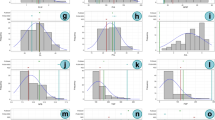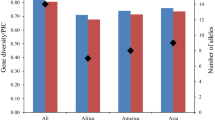Abstract
A set of 90 Indian soybean landraces were analysed for polymorphism at 43 SSRs and five allele specific markers of four major genes involved in regulating flowering and photoperiod response. A total of 42 polymorphic SSRs had amplified 126 alleles which served as raw data for estimation of genetic relationship and population structure among 90 accessions. Rare alleles of four and three SSRs were detected in accessions IC18768 and IC15089, respectively. Gene diversity in the population ranges from 0.065 to 0.717 with a mean value of 0.411. The polymorphism information content of 42 SSRs varied from 0.063 to 0.668. Hierarchical clustering based on neighbour-joining method identified three major clusters among 90 soybean accessions. Model based population structure analysis divided the 90 soybean accessions into four populations (K = 4). Mean value of Fst for different populations ranged between 0.4143 and 0.7239. Genotyping of 90 accessions with allele specific markers had identified accession IC15089 as triple recessive mutant of flowering genes E1, E2 and photoperiod sensitivity gene E3. The triple mutant IC15089 (e1, e3, e3) had been characterized phenotypically and identified as early maturing (88 days) and photoperiod insensitive genotype under extended photoperiod. The present study characterized genetic relationship among 90 Indian soybean landraces and had identified a few diverse and unique genotypes for utilization in soybean breeding programmes targeting development of short duration and photoperiod insensitive varieties through marker assisted selection.




Similar content being viewed by others
References
Abe J, Xu DH, Suzuki Y, Kanazawa A, Shimamoto Y (2003) Soybean germplasm pools in Asia revealed by nuclear SSRs. Theor Appl Genet 106:445–453
Bisen A, Khare D, Nair P, Tripathi N (2015) SSR analysis of 38 genotypes of soybean [Glycine max (L.) Merr.] genetic diversity in India. Physiol Mol Biol Plants 21:109–115
Buzzell RI (1971) Inheritance of a soybean flowering response to fluorescent day length conditions. Can J Genet Cytol 13:703–707
Buzzell RI, Voldeng HD (1980) Inheritance of insensitivity to long day length. Soybean Genet Newsl 7:26–29
Chauhan DK, Bhat JA, Thakur AK, Kumari S, Hussain Z, Satyawathi CT (2015) Molecular characterization and genetic diversity assessment in soybean [Glycine max (L.) Merr.] varieties using SSR markers. Ind J Biotechnol 14:504–510
Chauhan DK, Bhat JA, Thakur AK et al (2017) Understanding genetic relationship and population structure of Indian soybean varieties using microsatellite markers. Proc Natl Acad Sci India, Sect B Biol Sci. https://doi.org/10.1007/s40011-017-0847-y
Cober ER, Voldeng HD (2001) A new soybean maturity and photoperiod-sensitivity locus linked to E1 and T. Crop Sci 41:698–701
Cober ER, Tanner JW, Voldeng HD (1996) Soybean photoperiod-sensitivity loci respond differentially to light quality. Crop Sci 36:606–610
Dieringer D, Schlötterer C (2003) Two distinct modes of microsatellite mutation processes: evidence from the complete genomic sequences of nine species. Genome Res 13:2242–2251
Doyle JJ, Doyle JL (1990) Isolation of plant DNA from fresh tissue. Focus 12:13–15
Earl DA, Vonholdt BM (2012) STRUCTURE HARVESTER a website and program for visualizing STRUCTURE output and implementing the Evanno method. Conserv Genet Resour 4:359–361
Evanno G, Regnaut S, Goudet J (2005) Detecting the number of clusters of individuals using the software STRUCTURE: a simulation study. Mol Ecol 14:2611–2620
FAOSTAT (2018) http://www.fao.org/faostat/en/#data/QC. Accessed 12 Apr 2018
Fu YB, Peterson GW, Morrison MJ (2007) Genetic diversity of Canadian soybean cultivars and exotic germplasm revealed by simple sequence repeat markers. Crop Sci 47:1947–1954
Ghosh J, Ghosh PD, Choudhury PR (2014) An assessment of genetic relatedness between soybean [Glycine max (L.) Merrill] cultivars using SSR markers. Am J Plant Sci 5:3089–3096
Gireesh C, Husain SM, Shivakumar M, Satpute G, Kumawat G, Arya M, Agarwal DK, Bhatia VS (2017) Integrating principal component score strategy with power core method for the development of core collection in Indian soybean germplasm. Plant Genetic Resour 15:230–238. https://doi.org/10.1017/S1479262115000556
Gupta S, Manjaya JJ (2017) Genetic diversity and population structure of Indian soybean [Glycine max (L.) Merr.] revealed by simple sequence repeat markers. Crop Sci Biotechnol 20:221. https://doi.org/10.1007/s12892-017-0023-0
Gupta S, Bhatia VS, Kumawat G, Thakur D, Singh G, Tripathi R et al (2017) Genetic analyses for deciphering the status and role of photoperiodic and maturity genes in major Indian soybean cultivars. J Genet 96:147–154
Gyu TC, Jeongran L, Jung KM, MunSup Y, Hyung JB, Jung HK, TaeSan K, NamChon P, Paek P (2008) Genetic diversity and population structure of Korean soybean landrace [Glycine max (L.) Merr.]. J Crop Sci Biotech 11:83–90
Hipparagi Y, Singh R, Choudhury DR, Gupta V (2017) Genetic diversity and population structure analysis of Kala bhat [Glycine max (L.) Merrill] genotypes using SSR markers. Hereditas 154:9. https://doi.org/10.1186/s41065-017-0030-8
Hudcovicova M, Kraic J (2003) Utilisation of SSRs for characterization of the soybean [Glycine max (L.) Merr.] genetic resources. Czech J Genet Breed 39:120–126
Jiang B, Nan H, Gao Y, Tang L, Yue Y et al (2014) Allelic combinations of soybean maturity loci E1, E2, E3 and E4 result in diversity of maturity and adaptation to different latitudes. PLoS ONE 9(8):e106042. https://doi.org/10.1371/journal.pone.0106042
Kondetti P, Jawali N, Apte SK, Shitole MG (2012) Comparative study of genetic diversity in Indian soybean [Glycine max L. Merr.] by AP-PCR and AFLP. Ann Biol Res 3:3825–3837
Kong F, Nan H, Cao D, Li Y, Wu F, Wang J et al (2014) A new dominant gene E9 conditions early flowering and maturity in soybean. Crop Sci 54:2529–2535
Kumawat G, Singh G, Gireesh C, Shivakumar M, Arya M, Agarwal DK, Husain SM (2015) Molecular characterization and genetic diversity analysis of soybean [Glycine max (L.) Merr.] germplasm accessions in India. Physiol Mol Biol Plants 21:101–107
Langewisch T, Zhang H, Vincent R, Joshi T, Xu D et al (2014) Major soybean maturity gene haplotypes revealed by SNPViz analysis of 72 sequenced soybean genomes. PLoS ONE 9(4):e94150. https://doi.org/10.1371/journal.pone.0094150
Langewisch T, Lenis J, Jiang GL, Wang DC, Pantalone V, Bilyeu K (2017) The development and use of a molecular model for soybean maturity groups. BMC Plant Biol 17:91. https://doi.org/10.1186/s12870-017-1040-4
Li Y, Guan R, Liu Z, Ma Y, Wang L, Li L, Lin F, Luan W, Chen P, Yan Z, Guan Y, Zhu L, Ning X, Smulders MJM, Li W, Piao R, Cui Y, Yu Z, Guan M, Chang R, Hou A, Shi A, Zhang B, Zhu S, Qiu L (2008) Genetic structure and diversity of cultivated soybean [Glycine max (L.) Merr.] landraces in China. Theor Appl Genet 117:857–871
Liu K, Muse SV (2005) PowerMarker: integrated analysis environment for genetic marker data. Bioinformatics 21:2128–2129
Liu B, Kanazawa A, Matsumura H, Takahashi R, Harada K, Abe J (2008) Genetic redundancy in soybean photoresponses associated with duplication of phytochrome A gene. Genetics 180:996–1007
Oliveros JC (2007) VENNY. An interactive tool for comparing lists with Venn Diagrams. http://bioinfogp.cnb.csic.es/tools/venny/index.html. Accessed 25 Sept 2018
Pritchard JK, Stephens M, Donnelly P (2000) Inference of population structure using multilocus genotype data. Genetics 155:945–959
Satyavathi CT, Bhat KV, Bharadwaj C, Tiwari SP, Chaudhary VK (2006) AFLP analysis of genetic diversity in Indian soybean [Glycine max (l.) merr.] varieties. Genet Resour Crop Evol 53:1069. https://doi.org/10.1007/s10722-005-0779-x
Singh RK, Bhat KV, Bhatia VS, Mohapatra T, Singh NK (2008a) Association mapping for photoperiod insensitivity trait in soybean. Natl Acad Sci Lett 31:281–283
Singh RK, Bhatia VS, Yadav S et al (2008b) Identification of genetically diverse genotypes for photoperiod insensitivity in soybean using RAPD markers. Physiol Mol Biol Plants 4:369–375. https://doi.org/10.1007/s12298-008-0036-9
Singh RK, Bhatia VS, Bhat KV, Mohapatra T, Singh NK, Bansal KC, Koundal KR (2010) SSR and AFLP based genetic diversity of soybean germplasm differing in photoperiod sensitivity. Genet and Mol Bio 33:319–324
Tsubokura Y, Matsumura H, Xu M, Liu B, Nakashima H et al (2013) Genetic variation in soybean at the maturity locus E4 is involved in adaptation to long days at high latitudes. Agronomy 3:117–134
Tsubokura Y, Watanabe S, Xia Z, Kanamori H, Yamagata H, Kaga A et al (2014) Natural variation in the genes responsible for maturity loci E1, E2, E3 and E4 in soybean. Ann Bot 113:429–441
Vinu V, Singh N, Vasudev S, Yadava DK, Kumar S, Naresh S, Bhat SR, Prabhu KV (2013) Assessment of genetic diversity in Brassica juncea (Brassicaceae) genotypes using phenotypic differences and SSR markers. Rev Biol Trop 61:1919–1934
Wang KJ, Takahata Y (2007) A preliminary comparative evaluation of genetic diversity between Chinese and Japanese wild soybean (Glycine soja) germplasm pools using SSR markers. Genet Resour Crop Evol 54:157–165
Wang L, Guan R, Zhangxiong L, Chang R, Qiu L (2006) Genetic diversity of Chinese cultivated soybean revealed by SSR markers. Crop Sci 46:1032–1038
Wang M, Li R, Yang W, Du W (2010) Assessing the genetic diversity of cultivars and wild soybeans using SSR markers. Afr J Biotechnol 9:4857–4866
Wang YH, Zhang XJ, Fan SJ (2015) Genetic diversity of wild soybean populations in Dongying, China, by simple sequence repeat analysis. Genet Mol Res 14:11613–11623
Watanabe S, Hideshima R, Xia Z, Tsubokura Y, Sato S, Nakamoto Y et al (2009) Map-based cloning of the gene associated with the soybean maturity locus E3. Genetics 182:1251–1262
Watanabe S, Xia Z, Hideshima R, Tsubokura Y, Sato S, Harada K (2011) A map-based cloning strategy employing aresidual heterozygous line reveals that the GIGANTEA gene isinvolved in soybean maturity and flowering. Genetics 188:395–407
Watanabe S, Harada K, Abe J (2012) Genetic and molecular bases of photoperiod responses of flowering in soybean. Breed Sci 61:531–543
Xia Z, Watanabe S, Yamada T, Tsubokura Y, Nakashima H, Zhai H et al (2012) Positional cloning and characterization reveal the molecular basis for soybean maturity locus E1 that regulates photoperiodic flowering. Proc Natl Acad Sci 109:E2155–E2164
Xu M, Xu Z, Liu B, Kong F, Tsubokura Y, Watanabe S et al (2013) Genetic variation in four maturity genes affects photoperiod insensitivity and PHYA-regulated post-flowering responses of soybean. BMC Plant Biol 13:91
Zhai H, Lü S, Wang Y, Chen X, Ren H et al (2014) Allelic variations at four major maturity e genes and transcriptional abundance of the E1 gene are associated with flowering time and maturity of soybean cultivars. PLoS ONE 9(5):e97636. https://doi.org/10.1371/journal.pone.0097636
Zhao C, Takeshima R, Zhu J, Xu M et al (2016) A recessive allele for delayed flowering at the soybean maturity locus E9 is a leaky allele of FT2a, a flowering locus T ortholog. BMC Plant Biol 16:20. https://doi.org/10.1186/s12870-016-0704-9
Zhou Z, Jiang Y, Wang Z, Gou Z, Lyu J, Li W et al (2015) Resequencing 302 wild and cultivated accessions identifies genes related to domestication and improvement in soybean. Nat Biotechnol 33:408–414
Author information
Authors and Affiliations
Corresponding author
Ethics declarations
Conflict of interest
The authors declare that they have no conflict of interest.
Electronic supplementary material
Below is the link to the electronic supplementary material.
Rights and permissions
About this article
Cite this article
Kumawat, G., Yadav, A., Satpute, G.K. et al. Genetic relationship, population structure analysis and allelic characterization of flowering and maturity genes E1, E2, E3 and E4 among 90 Indian soybean landraces. Physiol Mol Biol Plants 25, 387–398 (2019). https://doi.org/10.1007/s12298-018-0615-3
Received:
Revised:
Accepted:
Published:
Issue Date:
DOI: https://doi.org/10.1007/s12298-018-0615-3




